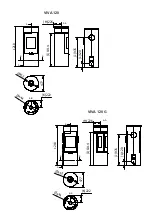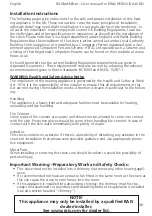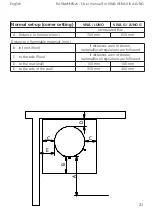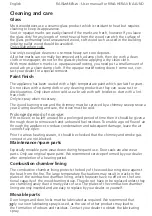
27
English
RAIS/
attika
- User manual for RINA-HERA-VIVA-JUNO
Room ventilation
There must not be an extractor fan fitted in the same room as the stove as this can
cause the stove to emit smoke and fumes into the room.
The stove requires a permanent and adequate air supply in order for it to operate safely
and efficiently.
In accordance with current Building Regulations the installer may have fitted a perma-
nent air supply vent into the room in which the stove is installed to provide combustion
air. This air vent should not under any circumstances be shut off or sealed.
Drying and storage
Drying wood takes time. Proper air drying takes approx. 2 years.
Here are some tips:
• Store the wood sawn, split and stacked in an airy, sunny place, which is protected
against rain (the south side of the house is particularly suitable).
• Store the firewood stacks at a hand’s breadth apart, as this ensures that the air
flowing through takes the moisture with it.
• Avoid covering the firewood stacks with plastic, as this prevents the moisture from
escaping.
• It is a good idea to bring the firewood into the house 2-3 days before you need it.
Regulating the combustion air
The stoves are equipped with a one-handed operating lever for regulating the damper.
The stove-specific regulating mechanisms can be seen on the diagrams (front of manu-
al).
The primary air is added to the primary combustion zone at the bottom of the burning
chamber, i.e. the bed of glowing embers. This cold air is only used in the lighting stage.
Secondary air is the air, added to the gas combustion zone, meaning air, which con-
tributes to the combustion of the pyrolysis gasses (preheated air, used for cleaning the
glass and combustion). This air is sucked through the damper below the burning cham-
ber and is pre-heated through the side channels and then emitted as hot scavenging air
onto the glass. The hot air rinses the glass and keeps it soot-free.
Tertiary air at the back of the burning chamber at the top (row of holes) ensures the
combustion of the final gas residues and particles before leaving through the chimney.
The pilot nozzles are placed at the bottom and front of the combustion chamber. They
ensure that the bed of glowing embers is fed with air and therefore holds a high tem-
perature. It provides a quick start when refuelling and reduces the risk of fire going out.
By setting the interval between position 1 and 2, the energy content in the firewood is
used optimally, as there is oxygen for combustion and for the burning of the pyrolysis
gasses. When the flames are a clear yellow the damper has been set correctly. Finding
the correct position comes with time after you have used for stove for a while.
It is not recommended that you turn it down completely. A mistake commonly made
is shutting the damper too early because it feels too hot. This results in dark smoke
emanating from the chimney and in the calorific value of the firewood not being used
to its fullest.
Summary of Contents for Viva Series
Page 11: ...B B A A B B A A 1067 I 219 M 120 L 992 J 219 470 40 447 214 K HERA...
Page 12: ...A A B B A A B B VIVA 98 G B B A A B B A A VIVA 98...
Page 13: ...B B A A B B A A VIVA 120 G B B A A B B A A VIVA 120...
Page 31: ...31 4 1 2 3 5 6 7 English RAIS attika User manual for RINA HERA VIVA JUNO...
Page 37: ...37 English RAIS attika User manual for RINA HERA VIVA JUNO...
Page 45: ...45 English RAIS attika User manual for RINA HERA VIVA JUNO...
Page 46: ...4 3 5 2 10 8 7 6 12 11 9 1 13 RINA 90...
Page 47: ...4 3 5 2 10 8 7 6 12 11 9 1 13 14 15 16 17 Hera...
Page 48: ...2 4 1 5 6 9 7 11 10 23185 VIVA 9 3 12 8 2 4 11 1 10 9 7 6 5 12 3 8 VIVA 120 VIVA 98...
Page 50: ...1 2 10 8 1 9 5 3 4 6 7 JUNO 120 JUNO 166...
Page 51: ...1 2 3 4 4 5 6 7 8 9 10 11 12 13 JUNO 120 G JUNO 166 G...
















































